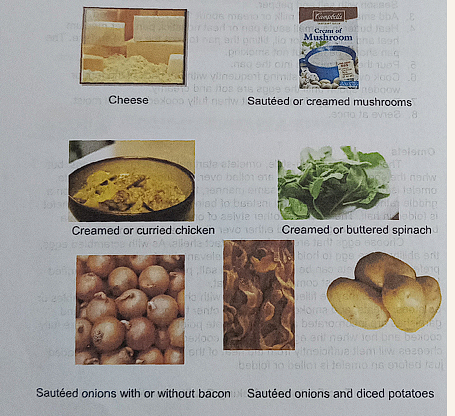COOKERY SUMMATIVE
1/56
There's no tags or description
Looks like no tags are added yet.
Name | Mastery | Learn | Test | Matching | Spaced |
|---|
No study sessions yet.
57 Terms
Eggs
- Poultry or fowl products that can be consumed in various forms.
- Acts as both an emulsifier and leavener
Bloom
Mucin layer that aids in the maintenance of its freshness. Protective coating on eggs that helps maintain freshness.
Mucin layer
Other name for Bloom.
False
It is advised to wash eggs.
Farm
Eggs are commercially produced here
Egg Shell
Accounts for 9-12% of total weight and serves as a defense against bacteria.
Air Cell
Forms as the egg cools, located at the large end of the egg.
Albumen (Egg White)
Comprises about 67% of the egg's liquid weight and consists of four layers.
Chalaza
Ropey strands anchoring the yolk, indicating freshness.
Germinal Disc
Also called Blastodisc. Entrance of the latebra for sperm in fertilized eggs, barely noticeable in table eggs.
Membranes
There are two kinds of this part of the egg.
Shell membrane
Just under the shell; has two parts.
Vitelline memberane
Covering the yolk, is the weakest at the Germinal disc.
Vitelline
Main protein in an egg; A lipoprotein; Contain phosvitin.
Outer shell membrane
Part of the shell membrane that sticks to the shell.
Inner shell membrane
Part of the shell membrane that sticks to the albumen.
Yolk
Makes up about 33% of the egg's liquid weight and serves as a food source for embryos.
Vitamin C
Only vitamin not in eggs
Shell and Interior quality
Two egg qualities
Egg Grading
Classifies eggs based on quality; grades in the Philippines are A, B, C, and D.
Breed, Age of Hen, Weight, Feed, and Environmental conditions.
Egg size factors
Fresh, Frozen, and Dried
Market Forms of Eggs
Fresh eggs
Most used. Sold individually or in trays.
Frozen eggs
Has multiple yolks. Pasteurized and must be thawed before use.
Dried eggs
Rarely used. Primarily used in the food industry, not commonly sold to consumers.
Processed Egg Products
Include bulk or fluid whole eggs, egg whites, and yolks.
Egg Substitutes
Can be egg-free or made from egg whites, important for low-cholesterol diets.
Pasteurized eggs
Are used in recipes requiring raw eggs.
Dried powdered eggs
Are useful for baking and food service.
Candling, Clicking, Shaking, Water Test, Breaking
Freshness Testing Methods
Culinary Arts
Refers to the artistic preparation of food which includes plating, garnishing, and appeal of the service of the dish.
Eggs
Main Protein dish or accessory in various dishes. Can be cooked with dry heat, moist heat, with or without oil. Serve as thickening agents, binders, and leavening agents.
Overcooking
Can cause greenish discoloration at yolk and white interface.
Frothy, Soft foam, Stiff foam, and Dry foam
Stages in foam formation
Functional Foods
Are foods that may have health benefits beyond their traditional nutritional value it contains lutien and zeaxanthin that reduce the risk of cataracts and muscular degeneration.
Designer Foods
Are foods that have been modified through biotechnology to enhance their quality or nutritional value it contains omega-3-polyunsaturated fatty acids and vitamin E.
Hard-cooked, Coddled, Soft-cooked, and Medium-cooked
Types of eggs cooked in the shell.
Hard-cooked
-12 minutes for small eggs,13 minutes for medium eggs,14-15 minutes for large eggs and 15 minutes for extra large eggs.
Coddled
- put cold eggs into already simmering water and simmer for 30 seconds.
Soft-cooked
-put cold eggs into already simmering water and simmer for 3 to 4 minutes.
Medium-cooked
-put cold eggs into already simmering water and simmer for 5-7 minut
Poached eggs
Prepared by slipping shelled eggs into barely simmering water and gently cooking until the egg holds its shape. The fresher the egg, the more centered the yolk, the less likely the white is spread and become ragged
Sunny side up, Basted, Over easy, and Over hard.
Types of Fried eggs
Scramble Eggs
-eggs ccan be stirred constantly over low heat for soft delicate curd and creamy texture
-stirred less frequently as they took for a larger curd and a firm texture.
*must be served hot, fresh and moist
Omelets
Is a dish made from eggs, fried with butter or oil in a frying pan. It is a common practice for an omelette to include fillings such as chives, vegetables, mushrooms, meat (often ham or bacon) cheese, onions or some combination of the above. Whole eggs or egg whites are often beaten with a small amount of milk cream or water.
High heat and a conditioned omelette pan
Two factors of making high quality omelets
Suggested omelette fillings

Set the table properly
Choose plates wisely
Read the clock
Create height in presentation
Be odd
Play with color and texture
Garnish appropriately
Seven simple ways to present food like a chef
Cold Storage
Includes refrigerated, deep chilling, and freezer storage.
Dry Storage
Keep eggs dry, cool, and well-ventilated.
Storage Tips
Store eggs in their carton and away from strong odors.
45 F or below
Temperature eggs should be stored.
Closed container
Where eggs should be stored
Occupational Health and Safety (OHS)
Is a cross-disciplinary area concerned with protecting the safety, health and welfare of people engaged in work or employment. Knowing this is essential to minimize the hazards and risks not only to students, trainers and other people within the training institution but also to others who will be affected.
Food-borne illness
Is a disease that is carried and transmitted to people by food.
Food-borne infection
Is a disease that results from eating food containing harmful micro-organism.
Food-borne intoxication
Is a disease that results from eating food containing toxins from bacteria, molds or certain plants or animals.